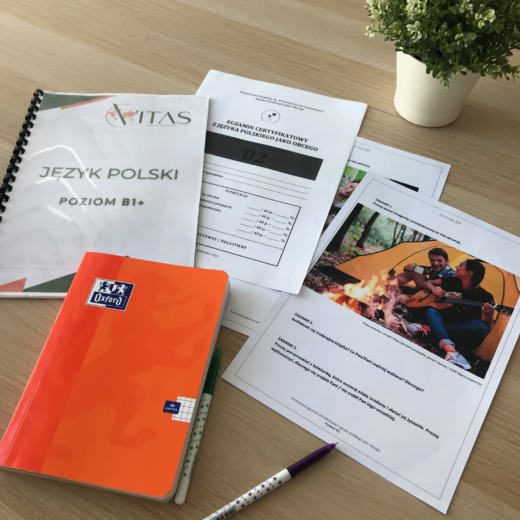
What You Should Know Before Taking the Official B1-Level Polish Language Exam
The B1-level Polish language certificate exam is a key step for anyone wishing to officially confirm their language skills.
Many people preparing for the exam wonder what it looks like, what tasks it includes, and which strategies will help achieve the best possible results.
In this article, we’ve gathered the 11 most frequently asked questions about the exam along with answers from an expert – examiner and teacher at Vitas School, Mirosława Mazan.
1. What is the general structure of the B1-level Polish language exam?
The B1-level certificate exam is divided into two parts: written and oral. The written part consists of four modules and lasts 190 minutes, while the oral part consists of three tasks and lasts up to 15 minutes.
2. How much time is allocated for each part of the exam?
The written part includes 4 modules:
- Writing (one set with two tasks – 200 words) – 75 minutes
- Listening comprehension – 5 tasks to be completed in 30 minutes
- Reading comprehension – 5 tasks, 40 minutes
- Grammar accuracy – 8 tasks, 45 minutes
The oral part contains three tasks: describing a photo, a monologue on a given topic, and a dialogue with the examiner according to the task instructions. The examine has 15 minutes to complete these tasks.

3. Are there any breaks provided?
After each module, students usually have a 15–20 minute break.
4. What can you bring to the exam?
You may bring 2 non-erasable pens (black or blue), water, and an ID document.
5. How are the different parts of the exam assessed, and what is the key to success?
Each written module is worth 30 points, and the oral part is worth 40 points.
You need to score at least 50% in each module to pass the exam.
6. What is the procedure for the oral part?
In the oral part, you randomly draw one of three exam sets and, after a short preparation time (up to 5 minutes), respond in front of the commission.
More details on this can be found in our preparatory course.
7. What types of tasks are included in the oral part of the exam?
The oral exam includes 3 tasks:
- describing a photo,
- a monologue on a given topic,
- a dialogue with the examiner according to the task instructions.
8. Can you take both the written and oral parts on the same day?
Yes, the written and oral parts of the exam can be taken on the same day.
9. How can you deal with anxiety and time pressure during the exam?
Anxiety and stress will be significantly reduced if the examinee knows and understands the exam format. Regular practice beforehand, vocabulary study, listening practice, and speaking exercises are key to success.
10. Are there any common traps or difficult tasks in the B1 exam to watch out for?
First trap: the first task in the listening module is played only once – students must be prepared for that.
Second trap: get “friendly” with the Polish alphabet and know how to write letters correctly, especially ł, k, r.
Third difficulty: at any time of day or night, students must know that the ending “–li” is for the masculine personal gender, and “–ły” for the non-masculine personal.
The ending “-li” is used for masculine personal subjects, meaning when the group includes at least one man. For example: “Oni przyszli” (They came), “Nauczyciele rozmawiali” (The teachers talked).
Meanwhile, the ending “-ły” is used for non-masculine personal subjects, such as groups consisting only of women, children, objects, or animals. For example: “One przyszły” (They came – females), “Uczennice rozmawiały” (The students talked – all girls).
11. What would you advise someone who is just starting to learn Polish and wants to pass the exam?
Those who are just starting to learn Polish and want to pass the exam should give themselves enough time to prepare, so that the knowledge and language skills stay with them long-term, and the exam becomes just a formality.
Summary
The B1 Polish language exam requires solid preparation, but with the right strategy and regular practice, it can be passed without major difficulties.
The key to success is understanding the structure of the exam, becoming familiar with typical tasks, and mastering time management.
It’s worth remembering that the exam not only confirms your language skills but also opens up many new educational and professional opportunities in Poland. Good luck!








